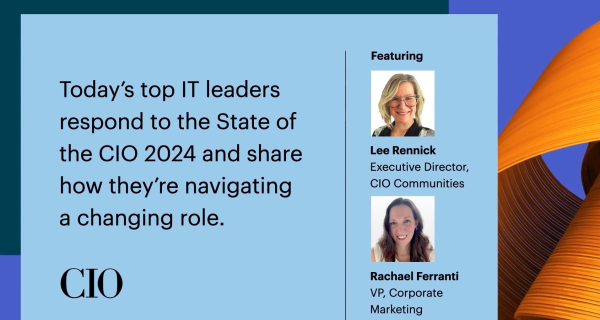As the roles of IT leaders evolve, see how one CIO is holding his vendors to new standards.
Every year, Foundry’s State of the CIO study takes a close look at what’s on the modern CIO’s radar for the year ahead. The study is always packed with valuable datapoints, but more importantly it reflects how the CIO role has evolved in recent years as our world careens in a wholly digital direction and virtually every company becomes a tech company first.
When we released this year’s State of the CIO study in January, one of the most telling datapoints was that 85% of CIOs now consider themselves to be a changemaker in their organization. In a conversation with my colleague Lee Rennick, I asked her to elaborate on what this datapoint means in the context of the remit for today’s CIO, and what tech marketers and vendors need to know to best support them.
As Executive Director of CIO Communities at Foundry, Lee speaks with some of the world’s most senior CIOs, CTOs, and IT leaders every day to gain a more rich and nuanced understanding of their changing role, their daily challenges, and their shaping visions.
For tech marketers aiming to better understand and support IT leaders in real and relevant ways, there isn’t a better brain to pick than Lee’s.
Asked to expand on the changemaker label, Lee noted that when COVID accelerated companies’ push to digital-first models, the CIO was propelled overnight as a business leader and strategist. Whereas in the past, the office of the CIO mainly supported the business through technology, recent years have seen the core value proposition become centered around that technology.
For CIOs that had to adjust to this shift in record time, they were looking to their vendors to support them, as Lee’s CIO Leadership Live guest Parm Sandhu, CIO at ISSofBC told her.

Building trusted vendor relationships is mandatory. The more they understand what we’re doing and why, the better equipped they are to help us on that journey.
“Building a trusted relationship with vendors is absolutely mandatory,” says Parm in the interview. “As an IT organization, we simply cannot keep up with the evolution, development, and pace of change in technology.” He goes on to say that he has come to rely on his vendors as a source of trusted guidance along ISSofBC’s strategic roadmap.
Parm’s approach to vendor evaluation and selection is no longer just about the products and services they sell out of the box—it now involves “opening up my strategy, my vision, and my aspirations” to them so that vendors can act more like partners and advisors to support Parm’s unique needs. “The more they understand what we’re doing, why we’re doing it, and where we want to get to,” he says, “the better equipped they are to help us on that journey.”
For CIOs like Parm who are looking to vendors to add strategic value in new ways than before, this also means those that can’t will be cut. “I’ve really looked at my vendors, at who’s helping me to get to the next level—and I’ve gone on a journey to consolidate,” he says.
In this new era of the changemaker CIO, there’s a clear call to action for technology vendors and marketers: now, more than ever, the CIO needs you to be all in on their vision. And because each CIO’s vision is unique, the way you communicate with them needs to be tailored to support them at each turn.
This flips our old approach of selling to the CIO on its head. Gone are the days of delivering a standard pitch and serving generic product information—they’re now looking to vendors to solve their challenges, bring new ideas to the table, and gain their trust to innovate alongside them.
In that way, I suppose you could also interpret the CIO’s changemaker status as making us change the way we market to them—to a way of real relationship building through shared commitment to their vision.
To learn more about how tech marketers can adapt to the changing role of the CIO, check out the rest of this video series, and download the 2024 State of the CIO today.



